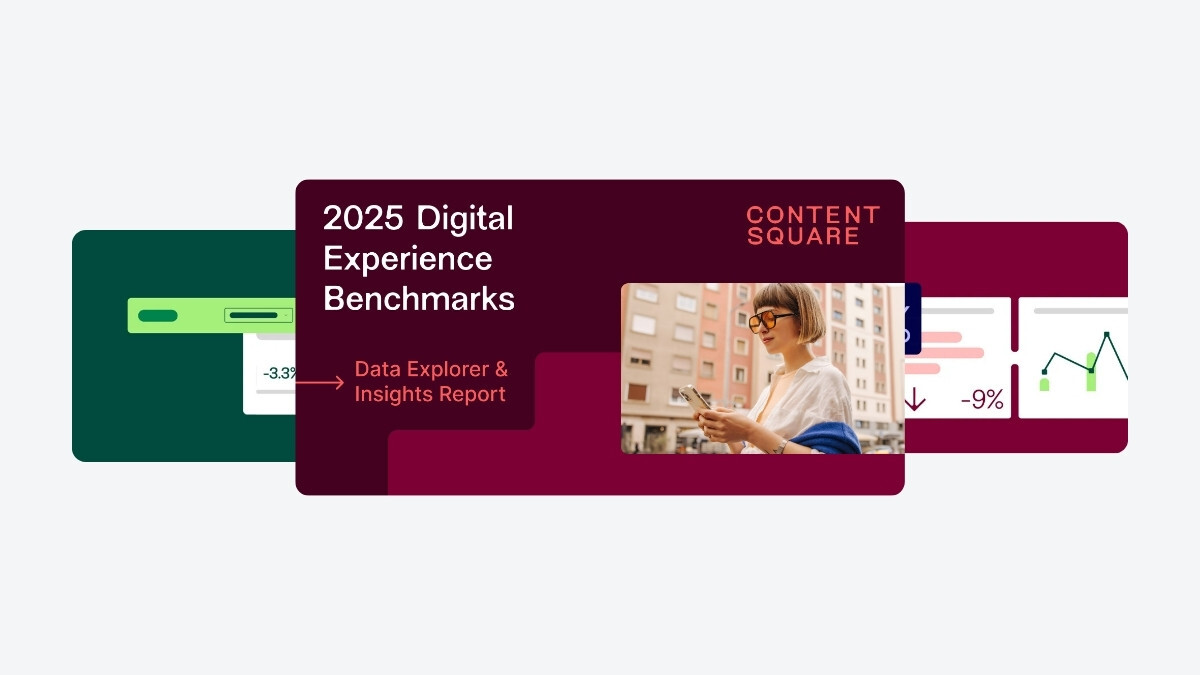2023 was a tough year for many e-commerce businesses, yet the industry has, since 2024, slowly started to recover. However, while the overall trend is improving, many businesses are still picking up the pieces. Customer acquisition costs continue to climb, competition is more intense, and the lingering effects of the past few years are still being felt. This is forcing businesses to rethink how and where they invest in customer engagement.
Data insights from the 2025 Contentsquare Benchmark Insights report include:
- The cost of a visit has increased by +9%
- Bounce rates on paid social are up +9.2%
- Conversions are down -10,6% on paid social
- Conversations overall have fallen with -6,1%
Avensia’s senior commerce advisors Sophie Vildahl and Åsa Steen break down what the data is really telling us and explore the shifts every e-commerce team should be paying attention such as: - The rise of acquisition costs and why increased ad spend doesn’t automatically lead to growth
- How organic strategies have been deprioritized and what that’s costing businesses
- The importance of CRM and being digitally disciplined
- Why bounce rates are so high on paid social and what to do about it
- Why gut feeling isn’t enough anymore and what to trust instead
Acquisition Fatigue: The Price of Visibility
Driving traffic to your site isn’t what it used to be. Customer acquisition costs have been rising steadily, with a 9% increase since last year according to Contentsquare's data. This is not just due to inflation or shifts in ad platforms, but because the entire digital landscape has become saturated. There are currently more competitors and more channels than ever before.
For many businesses, keeping up with global giants like Temu and Shein is a struggle. These players have claimed a significant share of the market, backed by huge marketing budgets that most brands simply cannot compete with. As a result, many companies feel pressured to compensate by increasing their own ad spend just to stay visible. But this strategy isn’t always effective, and in many cases, it’s driving acquisition costs to unsustainable levels.
Throwing more money at ads doesn’t automatically translate to growth, especially if the same money could be spent deepening customer relationships, improving site experience, or creating lifetime value. So, while the giants keep dominating with scale, the smarter move might be to play a different game entirely: one built around loyalty, relevance, and long-term value.
"We see how big of a focus and how much money companies seem to spend on paid media, not only to acquire new customers but also to get returning customers. But having the expertise that we do within CX and Loyalty, we are concerned that a lot of companies are not at the same time, or as a complement, investing more into how they work with CRM, loyalty and digital behavior online." – Sophie Vildahl, Senior Commerce Advisor at Avensia
This reliance on paid media highlights a broader issue: an overemphasis on short-term visibility at the expense of long-term value. And while performance marketing still has its place, it’s not sustainable as a stand-alone strategy.

High Bounce Rate for Paid Social
One thing that caught Sophie and Åsa’s attention was reading about the high bounce rate via paid social that companies are experiencing.
They believe that the issue stems from companies often not directing advertisements to the product being promoted but instead sending potential customers straight to the homepage. This creates unnecessary friction in the customer journey, especially on social platforms where ads often open in in-app browsers. Users are forced to close the shopping page in order to return to the app, making the process feel disconnected and inconvenient. Since social platforms are built to keep users within their own environment, not to support smooth external journeys, this setup often leads to dropped interest and lower conversion rates.
Organic? Forgotten, but Not Gone
When companies spend so much money on paid media, it’s easy to neglect organic marketing. Many have cut back on non-digital or long-term brand investments, funneling everything into channels with short-term attribution.
“It’s understandable that companies find it easier to buy visibility through advertising. But to increase organic traffic, really focusing on SEO and having relevant marketing campaigns online and offline is key.” – Åsa Steen, Senior Commerce Advisor at Avensia
This shift has led to major declines in organic search traffic, which in turn has led to declines in brand trust, brand awareness, and discoverability.

Where’s the CRM in All This?
The industry’s obsession with acquisition has left another area critically underused: Customer Relationship Management (CRM). In Sophie and Åsa’s experience, the potential of existing customer data, both to increase loyalty and to drive smarter acquisition, is still big.
An example that would improve this is lookalike modeling based on existing CRM profiles. It’s a simple idea, but it’s still underutilized. Instead of pushing ads to broad audiences, brands could be targeting users who resemble their most loyal customers. Yet many don’t.
Measurement That Matters
So how do you use the data you actually have? In a time of budget pressure and channel chaos, measurement is becoming more important than ever. The key isn’t just to track numbers but to track what matters. What’s happening on the site when visitors land there? Where do they drop off? What elements are engaging, and which ones are just noise?
Even more critical is connecting those insights to business goals. It’s not about having a dashboard; it’s about using that data to make informed decisions about content, user experience (UX), and campaign strategy. Digital experience analytics tools, such as Contentsquare, have the ability to help companies understand the real behavior behind the metrics.
Being Digitally Disciplined
Today’s media landscape is anything but linear. Customer journeys stretch across countless touchpoints. The complexity of these journeys makes it nearly impossible to optimize every interaction, but what matters is identifying and improving the journeys with the highest friction and the greatest potential for impact. This is where digital discipline becomes a differentiator.
Being digitally disciplined requires using digital experience analytics tools that provide a clear and centralized view of user behavior: a single source of truth (SSOT). With traffic coming from so many different sources, it’s essential to monitor how visitors interact with your site on a regular basis, ideally weekly. These tools not only make it easier to track patterns and friction points but also allow you to set up alerts when key metrics begin to drop.
“It’s important to constantly evaluate customer behavior online. The companies that are digitally disciplined across departments, those who break the silos and optimize the customer experience every week based on insights, are the ones who win.” – Åsa Steen
.

Mobile Loyalty Is on the Rise
Recent trends show that mobile shoppers are more likely to return within a month compared to last year, while desktop traffic continues to decline. Many companies have improved their mobile experiences in recent years, and it’s likely that these enhancements are now starting to pay off in the form of stronger retention and engagement.
But as mobile becomes the default, the question evolves: What more can you do to make your mobile experience stand out? For brands investing in apps, this means thinking beyond responsive design and starting to explore how mobile apps can drive deeper loyalty. Inspiring content, personalized journeys, and exclusive in-app features are just some of the ways to increase engagement and session duration.
Why Gut Feeling Isn’t Enough
Relying on gut feeling to understand customer behavior simply just isn’t enough anymore. Businesses need to make decisions based on real data, not assumptions. The truth is, no business can afford not to invest time or resources in getting to know their customers through analytics.
"I know we've been saying this for quite some time, but we still see that many companies are not making the time or investment to truly become more insight- and data-driven." – Sophie Vildahl
Before launching A/B tests, it’s crucial to have a solid understanding of how visitors behave, where they drop off, and what drives engagement. That means using data that’s not only reliable but also actionable. And thanks to AI-powered tools, much of this insight is now easier to access and analyze than ever before.
From Data to Loyalty
To sum up, many companies are sitting on valuable data that remains unused. With global competition intensifying, staying relevant across channels means understanding your audience on a deeper level. Here’s the uncomfortable truth: You may not be able to outspend the giants dominating the market. But you can outthink them.
That means
- Shifting from acquisition to loyalty: Build stronger customer relationships instead of constantly chasing new ones.
- Keeping track of your customers with data. What do your customers want? What can you do to make them more loyal? What creates loyalty? Use your data to find out, then act on it.
- Working smarter with data: Your CRM is full of potential. Use it to identify patterns and to deliver more personalized experiences.
- Bringing back organic strategies: Content still matters. So does SEO. These long-term efforts make a difference.
- Measuring meaningfully: Understand the why behind your metrics. Don’t just track. Translate.
If visitor engagement is dropping, it’s a red flag worth paying attention to. But rather than relying on guesswork, it’s essential to use data to understand what’s resonating and what’s not. Tools that track digital behavior can reveal which content formats drive interaction and which ones fall flat, whether it’s live shopping, 3D product views, blog posts, how-to guides, or more educational content. The key is knowing your audience and then tailoring your online content strategy to encourage deeper engagement, not just immediate conversions.
In short, stop relying solely on paid media. Start by identifying your most important segments and tailoring your messaging. Build a content strategy focused on engagement, not just conversion. With AI-driven digital experience analytics tools now making it easier than ever to act on customer behavior, there’s no reason not to. The brands that thrive in 2025 will be the ones that use their data, and use it wisely.
At Avensia, our CRM experts help you turn customer data into actionable insights. We implement and integrate platforms like Contentsquare to optimize the full customer journey. Want to see it in action? Book a demo or talk to our CX team today.
To get more insights, download the full Benchmark Insights report from ContentSquare here.











